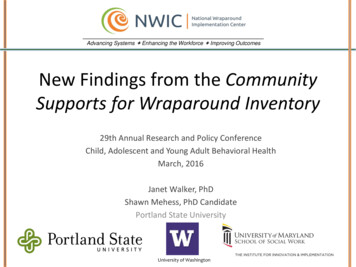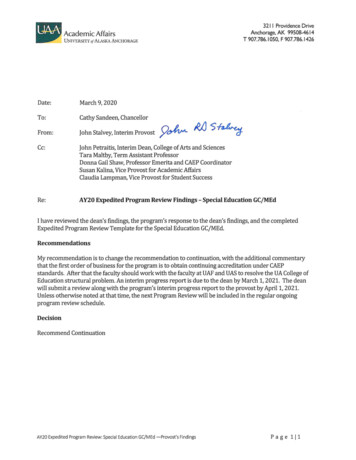
Transcription
Advancing Systems Enhancing the Workforce Improving OutcomesNew Findings from the CommunitySupports for Wraparound Inventory29th Annual Research and Policy ConferenceChild, Adolescent and Young Adult Behavioral HealthMarch, 2016Janet Walker, PhDShawn Mehess, PhD CandidatePortland State UniversityUniversity of Washington
The implementation contextHospitableSystem *Funding, PoliciesSupportiveOrganizationsEffectiveTeam* Process Principles Skills* Training, supervision,interagency coordination andcollaboration
Background- Rationale The Community Supports for WraparoundInventory assesses a community’s system-levelsupport for Wraparound– Multi-system collaboration is crucial to create a policyand funding context that is hospitable to Wraparound– System support linked to Wraparound fidelity (Bruns, etal., 2006) CSWI is strengths-based, and built on the idea thatcommunities gradually develop the capacity tosupport Wraparound
Background- Development Based on research on the “Necessary Conditions” forWraparound that emerged from a qualitative study(Walker & Koroloff, 2007) Refined through a formal consensus-building processusing advisors of the National Wraparound Initiative(Walker, Bruns & Penn, 2008) Evidence for reliability and validity emerged from thestudy of first seven communities (Walker & Sanders,2011); Factor structure confirmed in multi-level CFA onCSTI/SSTI (Walker, Koroloff and Mehess, 2015) Modest revisions after initial study
Structure of the CSWIThe CSWI includes 42 items grouped intosix themes: Theme 1: Community PartnershipTheme 2: Collaborative ActionTheme 3: Fiscal Policies and SustainabilityTheme 4: Access to Needed Supports & ServicesTheme 5: Human Resource Development &Support Theme 6: Accountability
Items & Reporting Each item has two “anchor” descriptions– “Least developed”—absence of collaboration– “Fully developed”—seamless support andcollaboration– Each item rated on a 5-point scale “don’t know” option Community report– Information on the sample and response– Scores for entire CSWI and each theme and item, andhow these relate to national means– Areas of greatest strength and challenge– Respondents’ comments
Administration CSWI is administered as a web-based survey– Communities identify a local lead who works withNWIC to create a list of stakeholders who haveappropriate knowledge Stakeholders include family, wraparound staff, partner staff,administrators– Stakeholders receive a link to the survey– Local lead and NWIC work to achieve good response Stakeholders can decline the survey, counts as non-response CSWI used in 7 sites in the original study, and 35additional sites 2010-2015 Mean response rate 69%
Overall and Theme Means and Comparison14Skagit CountyComparison2.39Overall Mean122.16Theme 1: CommunityPartnerships10Theme 2:Collaborative Action8Theme 3: Fiscal Policiesand Sustainability6Theme 4: Availability ofServices and Supports2.491.462.3942.91Theme 5: HumanResource Development2Theme way3.004.00FullyDeveloped
Theme 5: Item Means and ComparisonFAST ForwardComparison5.1: WraparoundJob Expectations125.2: Agency jobExpectations105.3: Caseload Sizes2.892.3883.065.4: ProfessionalDevelopment62.725.5: Supervision42.7425.6: Compensation forWraparound FullyDeveloped
Respondents 54 dropped due to insufficient dataOverall1100Rolefamily/youth consumerfamily advocate/partner/providerwrap facilitator/care coordinator or supervisornon-wrap direct service provider or supervisorhuman service organization mgr/adminother admincommunity partnertrainer; consultant; researcher108228619935331245other(no response)1253
sian/European AmericanLatino/HispanicNative-American/American IndianOther(no response)Received Intensive ServicesYesNo(no response)6416926471472621383057
CFA No problems skewness/kurtosis Imputation of missing data– “Amelia” package on default settings– 20 imputed datasets created and averaged Cronbach’s alpha for CSWI and themes– reliability: .79 α .94 CFA “Lavaan” package– Items specified to load freely on their intendedfactor– Indices showed good fit
Fit indicesχ2/dfTLIRMSEARMSEA ative 00.01Fiscal Policies and Sustainability3.530.980.060.080.02Access to Needed Supports .990.050.360.02CSWI2.060.910.070.110.06p .05SRMR .08Conventional Comparisonχ2 2 - 5TLI .9 RMSEA .09
Intraclass correlationsPartnershipsCollaborative ActionWorkforceFiscal Policies and SustainabilityAccess to Needed Supports 490.1700.1320.150
CSWI Theme Means
Specific Areas of Greatest Challenge Community StakeholdersRemoving Fiscal BarriersInfluential Youth/Young Adult VoiceCollective Fiscal ResponsibilitySustained fundingFiscal MonitoringFiscal UnderstandingCompensation for Wraparound StaffAddressing Barriers
Specific Areas of Greatest Challenge Community StakeholdersRemoving Fiscal BarriersInfluential Youth/Young Adult VoiceCollective Fiscal ResponsibilitySustained fundingFiscal MonitoringFiscal UnderstandingCompensation for Wraparound StaffAddressing Barriers
Specific Areas of Greatest Strength Community TeamProfessional DevelopmentEmpowered Community TeamGrievance ProcedureSupervisionCaseload SizesService/Support QualityWraparound Job ExpectationsFull Agency Support
Specific Areas of Greatest Strength Community TeamProfessional DevelopmentEmpowered Community TeamGrievance ProcedureSupervisionCaseload SizesService/Support QualityWraparound Job ExpectationsFull Agency Support
CSWI/Theme Scores Predicted by MeanExperience with WraparoundEstimatepAdj. R2Partnerships0.060.07 † 0.20Collaborative ActionFiscal Policies andSustainabilityAccess to Needed Supportsand Services0.060.140.130.03 * 0.320.060.07 † 3CSWI0.070.06 † 0.23N sites (35)0.11
CSWI/Theme Scores Predicted by Differencebetween Individual and Site ScoresEstimatepAdj. R2Partnerships0.000.480.00Collaborative ActionFiscal Policies andSustainabilityAccess to Needed Supportsand 0.860.00N respondents (1100)
Acknowledgments/FundersThe development of the contents of this presentation were supported by funding from the NationalInstitute of Disability and Rehabilitation Research, United States Department of Education, and theCenter for Mental Health Services Substance Abuse and Mental Health Services Administration,United States Department of Health and Human Services (NIDRR grant H133B090019). The contentdoes not represent the views or policies of the funding agencies. In addition, you should notassume endorsement by the Federal Government.
Theme Structure of theCommunity Supports forWraparound Inventory (CSWI)THE CSWI INCLUDES 42 ITEMS GROUPED INTO SIX THEMES:Theme 1: Community Partnership. Collective community ownership of and responsibilityfor Wraparound is built through collaborations among key stakeholder groups.Theme 2: Collaborative Action. Stakeholders take concrete steps to translate theWraparound philosophy into concrete policies, practices and achievements.Theme 3: Fiscal Policies and Sustainability. The community has developed fiscalstrategies to meet the needs of children participating in Wraparound and methods tocollect and use data on expenditures for Wraparound-eligible children.Theme 4: Access to Needed Supports & Services. The community has developedmechanisms for ensuring access to Wraparound and the services and supports that teamsneed to fully implement their plans.Theme 5: Human Resource Development & Support. The community supportswraparound and partner agency staff to work in a manner that allows full implementationof the wraparound model.Theme 6: Accountability. The community has implemented mechanisms to monitorwraparound fidelity, service quality, and outcomes, and to assess the quality anddevelopment of the overall wraparound effort.Each item has two “anchor” descriptions:– “Least developed”—absence of collaboration– “Fully developed”—seamless support and collaborationEach item rated on a 5-point scale– “don’t know” optionNational Wraparound Initiative: http://nwi.pdx.edu1
National Wraparound Initiative: http://nwi.pdx.edu2
CSWI is administered as a web-based survey -Communities identify a local lead who works with NWIC to create a list of stakeholders who have appropriate knowledge Stakeholders include family, wraparound staff, partner staff, administrators -Stakeholders receive a link to the survey -Local lead and NWIC work to achieve good response











